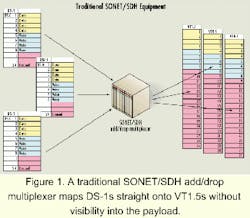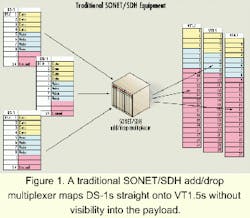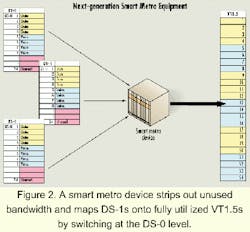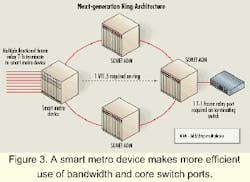Intelligent switching at the metro edge of SONET/SDH networks
Smart metro equipment works with existing legacy systems and allows carriers to optimize their use of network bandwidth for multiservice transport.
Louis Albuerne
Mayan Networks
SONET and SDH will continue as the de facto technologies for delivering highly reliable and scalable broadband network services in the metro area. SONET was originally developed to optimize voice rather than data-networking requirements, however. As data traffic in the metropolitan area network begins to overtake voice, existing SONET and SDH infrastructures present challenges for the delivery of multimegabit data services.
At the core of the problem is that typical user bandwidth requirements for data rarely fall within the deliverable SONET envelopes (see Table).
As a result of this mismatch, carriers are forced to deliver excess bandwidth to customers or deploy complex access equipment such as proprietary time-division multiplexing (TDM) devices or ATM inverse multiplexing (IMA) devices.
Although these challenges exist, it makes little sense to scrap the existing TDM/SONET infrastructures used during the last two decades. These infrastructures account for more than 70% of existing carrier networks. Thus, next-generation solutions must optimize and interoperate with the existing SONET and SDH infrastructures. These solutions must also offer a graceful migration path to emerging metro technologies such as Internet Protocol (IP) over WDM.SONET/SDH transport networks have long been scrutinized for their inefficiencies when dealing with packet-based data services. Legacy TDM devices such as add/drop multiplexers (ADMs) only provide Layer 1 functionality, grooming traffic for transport networks. For example, a 128-kbit/sec frame relay service is transported through the network, occupying an entire DS-1 payload before it reaches an infrastructure that can intelligently switch the data. That results in utilization of less than 9% of the circuit to deliver the service.
SONET/SDH equipment can also be inefficient when dealing with fractional voice circuits. Most legacy SONET/ SDH ADMs do not have visibility, much less switching capabilities, at the DS-0 level. This functionality predominantly exists within large, centralized digital-crossconnect-switch (DCS) infrastructures. Therefore, the fractional voice circuits from private branch exchanges (PBXs) and channel banks must be transported to this centralized infrastructure, which results in poor utilization of the access and transport networks. That explains why many SONET/SDH networks only exhibit 10% to 30% bandwidth efficiencies.To resolve these inefficiencies, industry startups are developing a new class of "smart" metro access switches that provide carrier-class, multiservice aggregation at the network edge. These devices incorporate standards-based SONET/SDH ADM functionality together with Layer 2, 3, and 4 packet-processing elements. A few of these devices also feature DS-0-level TDM switching through the use of embedded 3/1/0 DCS functionality. That allows carriers to distribute DCS functions at the network edge so customer traffic can be directly groomed at the DS-0 level as it enters the network.
By embedding 3/1/0 DCS, M13, and SONET ADM functions into a remotely manageable smart metro device, a carrier can realize cost savings as well as revenue creation and margin enhancement. Cost savings result as multiple products are consolidated into one device. Similarly, because only one device needs to be serviced, maintained, and trained upon, operational savings are realized. By efficiently grooming traffic at DS-0 granularities, bandwidth is conserved. This bandwidth can now be made available for additional customer sales.
Switching at the DS-0 level allows carriers to efficiently groom customer traffic into SONET virtual tributaries (VT1.5s) by combining the usable bandwidth from various fractional circuits. Traditional SONET ADMs can only transport fractional DS-1s within complete VT1.5s. Figure 1 illustrates how a traditional ADM maps DS-1s directly into VT1.5s. In this example, three DS-1s each carry four DS-0s of data traffic and four DS-0s of voice traffic, while the remaining 16 DS-0s are unused. A traditional SONET ADM would directly map each of these DS-1s onto a corresponding VT1.5, regardless of how fully utilized the incoming DS-1s are; thus, a tremendous amount of bandwidth is wasted.
With embedded DCS 3/1/0 functionality, a smart metro device can groom these three circuits into a single VT1.5 (see Figure 2). This type of grooming is made possible because the metro device has visibility as well as switching capabilities at the DS-0 level, unlike standard SONET ADMs.Using frame relay as an example, consider a service provider that has 12 T1s, each with 128-kbit/sec frame relay service, originating from a remote location. A traditional SONET ADM would consume 12 VT1.5s within a ring to transport these circuits. In addition to the ring bandwidth, the ADM at the central location would have to consume 12 DS-1 ports from another device such as a DCS or a frame relay switch. By performing DCS 1/0 functions on a remote smart metro device, the 12 DS-1s are consolidated into a single VT1.5 for transport, and only a single DS-1 port is required at the central location (see Figure 3).
By adding IP routing and Ethernet, frame relay, and ATM switching to the smart metro device, carriers can further optimize existing TDM infrastructures through statistical multiplexing and oversubscription of services. The ideal platform would allow carriers to plug only the required switching fabrics for their needs. Another desirable feature in these platforms is the ability to provision any combination of Layer 1, 2, and 3 services to any port on any module, regardless of the physical interface type.
In the frame relay example, the smart metro device would allow the carrier to oversubscribe customer services at the network edge. Using a conservative 2:1 oversubscription ratio, a carrier could aggregate and switch 24 DS-1s for 128-kbit/sec frame relay DS-1s into a single VT1.5 for transport. With the traditional ADM, utilization of a 128-kbit/sec service is about 8%. The smart metro device increases this utilization to approximately 200% and similarly decreases the number of central-office ports required to deliver the service. Another benefit from distribution of oversubscription to the network edge is a reduction in the amount of oversubscription that needs to be done in core data switches.
Protocol termination and translation, such as frame relay to ATM, are also desirable traits. These characteristics allow carriers to offer a range of services at the network edge, while at the same time translating the service to the protocol of choice for their backbone infrastructure. Another use would be extending Multiprotocol Label Switching (MPLS) backbone networks to the network edge where customer traffic originates in the wide area network (WAN).
Multitenant office buildings are ideal locations for smart metro equipment, because these devices can aggregate and switch a diverse array of services across multiple interfaces. The grooming and switching capability of the platform allows service providers to provision services in multimegabit increments whether the customer connection is transported point-to-point as in a transparent LAN service (TLS) or routed to the Internet.
As an example, consider a customer that requires a combined network capacity of 10 Mbits/sec for TLS. A TLS application creates a multimegabit virtual LAN service that transports all LAN-based protocols over a WAN infrastructure. Traditional SONET ADMs would require that this Ethernet port be mapped to an STS-1 for transport whether the customer requirement was 1.5, 6, or 10 Mbits/sec. Utilization for this service averages between 7% and 20%, limiting OC-3 rings to three such customers and OC-12 (622-Mbit/sec) rings to 12 such customers.One solution to this inefficiency is to aggregate the Ethernet connections into TDM inverse multiplexers, or ATM IMA access devices, that provide multiple DS-1 connections to the SONET ADM. This approach saves some bandwidth but requires a very large number of physical T1 ports throughout the network infrastructure in remote and central locations to multiplex and demultiplex these services. The access multiplexers also represent single points of failure throughout the network, because these devices typically do not have redundant backups.
To address this inefficiency, smart metro devices use mechanisms to bond DS-1s and/or VT1.5s to scale multimegabit requirements on 10/100 Ethernet interfaces. Ideally, this mechanism should be nonproprietary so that the logical bonding of circuits could be done in a multivendor environment. In the example earlier, the smart metro device should be able to use protocols like multilink point-to-point and ATM IMA to bond four VT1.5s to deliver a 6-Mbit/sec service and seven VT1.5s to deliver a 10-Mbit/sec service. The service provider can then transport this connection point-to-point or route IP packets across the logical interface. That increases the utilization for this service to approximately 95% before any oversubscription and the number of 10-Mbit/sec customers from three to eight in OC-3 rings and 12 to 33 in OC-12 rings.
Interoperability is critical if next-generation services are to successfully enter the metropolitan-network edge. While proprietary next-generation systems may find opportunities within niches, mass migration from legacy to next-generation solutions will require interoperability with metro networks from a physical, signaling, and control level.
This interoperability should extend to a carrier's existing operational support systems for management and provisioning. Smart metro devices are in essence combining the worlds of transmission networking with data networking. Vendors of these devices should offer a variety of management options to provide transmission engineers with a common interface such as Transaction Language-1 (TL-1) and data engineers with a familiar interface such as simple network-management protocol.
Of equal importance is the ability of the smart metro device to reduce the operational and maintenance costs of deploying networks. The consolidation of multiple devices into a single device will drive down hardware costs and should reduce the number of parts and components that would need to be spared by a service provider.
Other costs that may not be as obvious can also be reduced. The cost to train technicians is less, since only a single platform instead of multiple platforms is required. This cost factor is significant when average training costs for a growing carrier are approximately $3 million per year. The time to provision services is also reduced. If the smart metro device can provision any physical port with any Layer 1, 2, or 3 service, then provisioning and re-provisioning should require substantially less truck-rolls and can be accomplished remotely via management software. Finally, a reduction in physical footprint is realized since less space is required to deliver multiservices from a single platform. This reduction in space can have a tremendous savings in collocation facilities. With reduced equipment, carriers can also realize savings in overall power requirements.
The ability to offer, manage, switch, and translate differentiated services at the network edge gives carriers a competitive advantage over other network operators with limited ability to expand their product offerings. Ultimately, the ability to easily migrate these services into the backbone infrastructure-whether it is based on IP, ATM, or DWDM-allows carriers to provision just-in-time services, leading to higher revenues and increased margins.
Louis Albuerne is a senior systems engineer at Mayan Networks (San Jose, CA).




